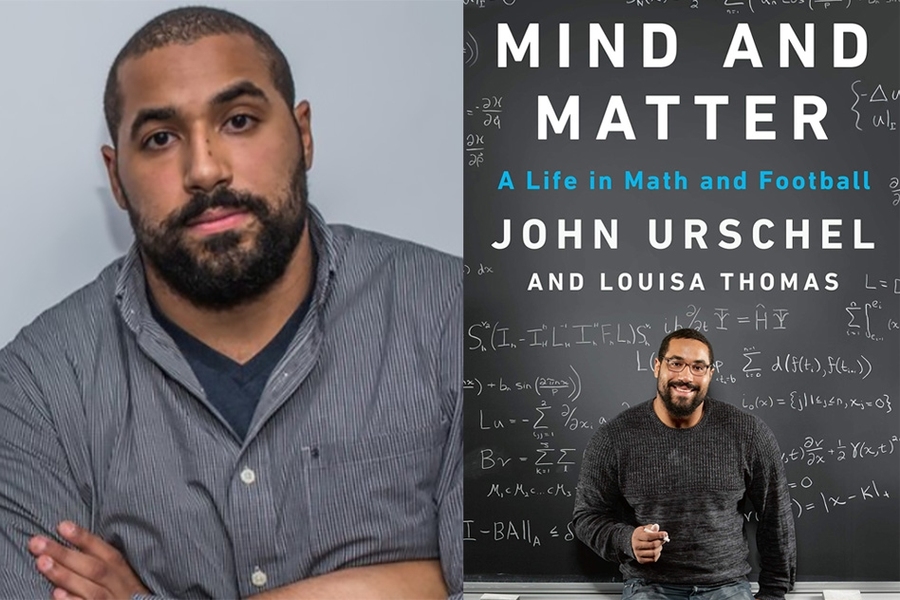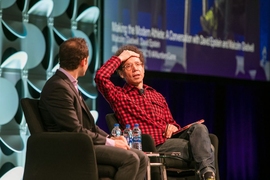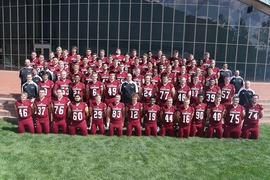It’s been nearly two years since John Urschel retired from the NFL at the age of 26, trading a career as a professional football player at the height of his game for a chance at a PhD in mathematics at MIT. From the looks of it, he couldn’t be happier.
The former offensive lineman for the Baltimore Ravens is now a full-time graduate student who spends his days in Building 2, poring over academic papers and puzzling over problems in graph theory, machine learning, and numerical analysis.
In his new memoir, “Mind and Matter: A Life in Math and Football,” co-written with his wife, journalist and historian Louisa Thomas, Urschel writes about how he has balanced the messy, physically punishing world of football, with the elegant, cerebral field of mathematics.
Urschel presents his life chronologically, through chapters that alternate in focus between math and football, as it often did in real life. For instance, he writes about a moment, following an ecstatic win as part of Penn State’s offensive line, when a coach pulled him aside with a message: With a little more work, he had a shot at the NFL.
With that in mind, he writes, “I went home elated. … I left the football building with a new sense of purpose, a mission.” That same night, he opened his laptop and got to work on a paper that he planned to submit with his advisor to a top linear algebra journal. “Suddenly, surprisingly, I had a strange feeling: I felt torn,” he recalls.
For those who see Urschel as a walking contradiction, or praise him as an exceptional outlier, he poses, in his book, a challenge:
“So often, people want to divide the world into two: matter and energy. Wave and particle. Athlete and mathematician. Why can’t something (or someone) be both?”
A refuge in math
Before he could speak in full sentences, Urschel’s mother could tell that the toddler had a mind for patterns. To occupy the increasingly active youngster, she gave him workbooks filled with puzzles, which he eagerly devoured at the kitchen table. As he got older, she encouraged him further, and often competitively, with games of reasoning and calculation, such as Monopoly and Battleship. And in the grocery store, she let him keep the change if he could calculate the correct amount before the cashier rang it up.
His mother made math a game, and by doing so, lit a lifelong spark. He credits her with recognizing and nurturing his natural interests — something that he hopes to do for his own toddler, Joanna, to whom he dedicates the book.
When he was 5 years old, he saw a picture of his father in full pads, as a linebacker for the University of Alberta — his first exposure to the sport of football. From that moment, Urschel wanted to be like his dad, and he wanted to play football.
And play he did, though he writes that he wasn’t driven by any innate athletic talent.
“The only thing that set me apart from other kids when I played sports was my intensity as a competitor. I couldn’t stand losing — so much so that I would do everything in my power to try to win,” Urschel writes.
This fierce drive earned him a full ride to Penn State University, where he forged a lasting connection with the college and its football team. His seemingly disparate talents in math and football started gaining some media attention, as a bright spot for Penn State in an otherwise dark period. (The team was facing national scrutiny as a consequence of the trial of former coach Jerry Sandusky.) But the more news outlets referred to him as a “student-athlete,” the more the moniker grated against him.
“[The term ‘student-athlete’] is widely considered a joke of sorts in America,” Urschel says. “But it’s something you can actually do. It takes up a great deal of your time, and it’s not easy. But it is possible to be good at sports while tearing it up in academics.”
Urschel proved this in back-to-back years at Penn State, culminating in 2013 with a paper he co-wrote with his advisor, Ludmil Zikatanov, on the spectral bisection of graphs and connectedness, which would later be named the Urschel-Zikatanov theorem. The following year, he was drafted, in the fifth round, by the Baltimore Ravens.
He played his entire professional football career as a guard with the Ravens, in 40 games over two years, 13 of which he started. In 2015, in a full-pads practice at training camp with the team, Urschel was knocked flat with a concussion. Just weeks earlier, he had learned that he had been accepted to MIT, where he hoped to pursue a PhD in applied mathematics, during the NFL offseason.
In the weeks following the concussion, he writes: “I’d reach for a theorem that I knew I knew, and it wouldn’t be there. I would try to visualize patterns, or to stretch or twist shapes — a skill that had always come particularly easy to me — and I would be unable to see the structures or make things move.”
He eventually did regain his facility for math, along with, surprisingly, his need to compete on the field. Despite the possibility of suffering another concussion, he continued to play with the Ravens through 2015. During the off-season, in January 2016, Urschel set foot on the MIT campus to begin work on his PhD.
A quantitative mindset
“It was like stepping into my personal vision of paradise,” Urschel writes of his first time walking through MIT’s math department in Building 2, noting the chalkboards that lined the hallways, where “casual conversations quickly became discussions of open conjectures.” Urschel was no less impressed by MIT’s football team, whose practices he joined each Monday during that first semester.
“These students have so much to do at MIT — it’s a very stressful place,” Urschel says. “And this is Division III football. It’s not high level, and they don’t have packed stands of fans — they’re truly just playing for the love of the game.”
He says he was reluctant to return to pro football that summer, and realized throughout that season that he couldn’t wait for Sundays and the prospect of cracking open a math book and tackling problems with collaborators back at MIT and Penn State.
An article in the New York Times in July 2017 tipped the scales that had, up until then, kept math and football as equal passions for Urschel. The article outlined a brain study of 111 deceased NFL players, showing 110 of those players had signs of CTE, or chronic traumatic encephalopathy, associated with repeated blows to the head. Urschel writes that the study didn’t change his love for football, but it did make him reevaluate his choices.
Two days after reading that article, Urschel announced his retirement from the NFL and packed his bags for a permanent move to MIT.
Since then, he has focused his considerable energy on his research, as well as teaching. Last spring, he was a teaching assistant for the first time, in 18.03 (Differential Equations).
“I love teaching,” says Urschel, who hopes to be a university math professor and encourages students in class to think creatively, rather than simply memorize the formulas that they’re taught.
“I’m fighting against the idea of blindly applying formulas you just learned, and instead teaching students to use their brains,” Urschel says.
He’s also making time to visit local high schools to talk math, and STEM education in general.
“I’m a visible mathematician,” says Urschel — an understatement to be sure. “I have a responsibility to try to help popularize math, and remove some of its stigma.”
His enthusiasm for the subject is highly effective, judging from the overwhelmingly positive reviews from his 18.03 students. Above all, though, he hopes to convey the importance of a “quantitative mindset.”
“I don’t care so much if a random person on the street knows the quadratic formula,” Urschel says. “But I do care if they’re able to think through different problems, whether involving loans of two different rates, or how much you need to put in your 401k. Being capable of thinking quantitatively — it’s the single most important thing.”










